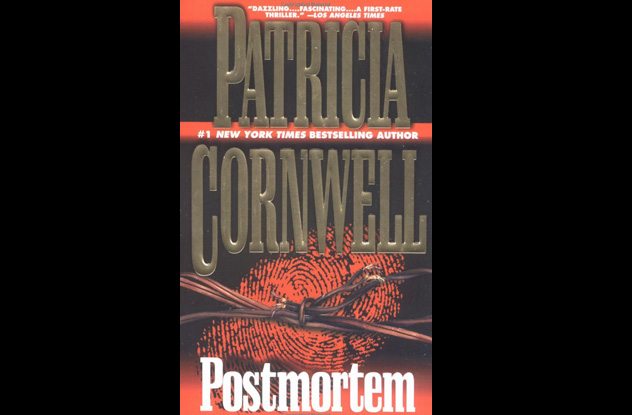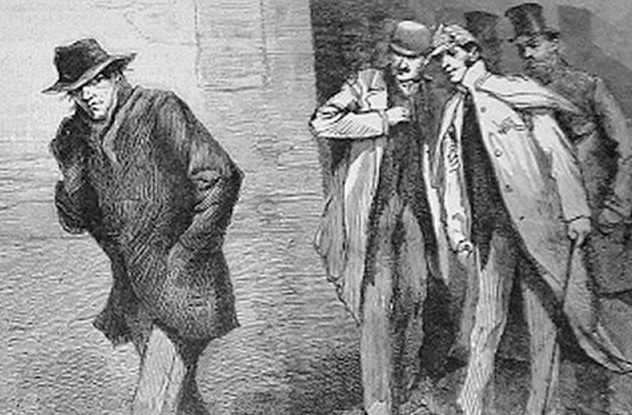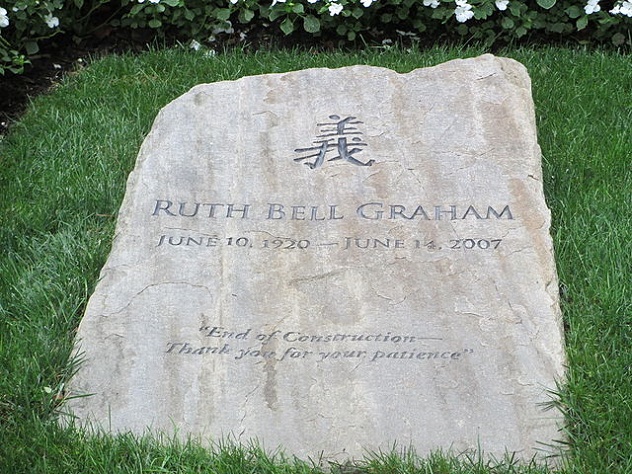But the drama isn’t limited to her books. Her own life has all the components of a best seller: backstory demons, a plotline that takes the main character from rags to riches, dramatic subplots intersecting and adding to the main storyline, and, of course, a love interest. But as with any masterful best seller, it’s the hard-charging, larger-than-life protagonist—who rides motorcycles, pilots helicopters, and hangs Dr. Seuss art on the walls of her Boston penthouse apartment—that’s truly the most interesting part of the story.
10Backstory Demons
Cornwell loves Dr. Seuss because the outcasts and kids in his books take charge of difficult situations. It was a while before she became as strong as these fictional heroes. Her family had lived an easy life in a yellow stucco home in Coral Gables, Florida until Christmas morning in 1961. Cornwell was only five years old when her prominent attorney father abandoned the family. The little girl clung to his leg, but he simply shook her off, took his suitcases, and left. Although still living in the family home, her clinically depressed mother was absent in her own way. Cornwell and her two brothers were left unsupervised, which took a dangerous turn for the five-year-old girl when she encountered a pedophile in the neighborhood shortly after her father left. It was a local policeman who lured her into his car, kissed her, and slid his hand into the pocket of her red shorts. Fortunately, her brother biked over to them before anything else could happen. The officer raced away, but his skinny build and rotten teeth are seared into her memory. She testified before a grand jury with her red shorts handed around as evidence. The officer already had a criminal record, but his background had never been investigated. She’s positive he went to prison, but there was no record of it when she checked as an adult. A couple of years after that incident, her financially struggling family relocated to a rental property in the religious conservative stronghold of Montreat, North Carolina. “I was the only child of divorced parents in my entire school,” remembers Cornwell. “We were made to feel like sinners coming from a broken home. I felt isolated.” Shortly after the move, her mother became hospitalized for four months for depression. Until she returned, the kids were shipped to a foster home. Cornwell remembers her foster mother as emotionally abusive. The woman criticized the young girl constantly, took away her dog, and forced her to eat foods that made her ill. Perhaps that contributed to Cornwell’s anxiety and anorexia as a teenager. When she was able to gain some control over her life, her anorexia disappeared.
9Reporter Patsy Daniels
In any good story, an incident propels the lead character into the main plot’s action. For Cornwell, that incident was her first job after college as a crime reporter at the Charlotte Observer. She went by the name of Patsy Daniels then. Cornwell was a go-getter who chased every lead until she got the story. Her experiences at the paper shaped her desire to write about forensics. “I’d get to a homicide scene, and the body was gone,” she said. “I wanted to know, what did they do with it? What is the body telling these people? I was just incredibly curious. So when I decided to try writing crime fiction I started doing research, met a medical examiner, got to see a facility in the labs. This was way back in 1984 where they were just starting to talk about something called DNA and lasers and I said, ‘Wow this is the world I want to know.’ ” Next, Cornwell snagged a job in the Richmond, Virginia medical examiner’s office. Her years of watching autopsies and working as a volunteer police officer provided the forensics knowledge she needed for her soon-to-be-published first novel.
8Rags To Riches
After having some early novels rejected, Cornwell swung into the second act of her life when she published her first crime thriller, Postmortem, in 1990. Although popular crime fiction is filled with forensic science now, no one had written in depth about the subject before Cornwell. Many publishers rejected the manuscript before Scribner reluctantly accepted it. “The message I got from New York publishers was that nobody wanted to read about laboratories or morgues,” said Cornwell. “And they certainly didn’t want to read about a woman [main character Kay Scarpetta] who works in places like that.” Initially, Cornwell received mostly scathing reviews. Plus, some reviewers referred to her main character as a man, and one bookseller even went so far as to change the character to a man by manually editing the printed books. She was almost ready to give up writing when Postmortem unexpectedly swept the literary awards that year. She was the first author to win the Anthony, the Creasey New Blood Dagger, the Edgar, the French Prix de Roman d’Adventure, and the Macavity award in the same year. She even met Princess Margaret when she accepted the Creasey award from the British Crime Writers Association. Her literary career was born. So was her ascent from rags to riches. To date, Cornwell has sold over 100 million books throughout the world. Most of them are from the Kay Scarpetta medical examiner series. Her writing income has allowed her to wear Armani clothing and indulge in luxuries such as a red Ferrari, a Bell 407 helicopter, and several Harley-Davidsons. She’s also been exceptionally generous, donating millions of dollars to causes ranging from animal rescue to literacy to law enforcement.
7Real-Life Research
Cornwell doesn’t limit herself to libraries and the Internet when she’s researching the facts she needs for a book. She does field research on ballistics, DNA analysis, and other areas of forensics. But she admits that her heroine, Kay Scarpetta, is also a larger-than-life character because her readers like adventure. Actual medical examiners couldn’t get as directly involved in their cases without exhausting themselves or dying from unnecessary danger. If Scarpetta goes to a firing range or scuba dives around a shipwreck, Cornwell does, too. It’s her way of getting the details correct to make the experiences come alive for her readers. Sometimes, it gets a little too gross even for her. Once, she made herself feel nauseated by writing about cannibalism while munching on rare roast beef. She doesn’t do that anymore. Cornwell has discovered one surprising change at crime scenes since forensic science has become popular on TV. In at least two burglaries, she arrived on scene to find the victims had bagged the evidence themselves. When Cornwell asked one woman why she did that, the woman replied: “I watch these [TV] shows and fingerprints aren’t important anymore.” Cornwell then let her in on a little trade secret: The woman had just ruined the evidence in her own case.
6The Minor Affair With Major Consequences
The subplots in Cornwell’s life have been dramatic and sometimes dangerous. However, a minor affair in the early 1990s took on exaggerated importance for Cornwell when jealous friends revealed details of her life that she wanted to keep private. “They were not happy about the huge success I was having and decided they wanted to be damaging,” said Cornwell. “Jealousy is a terrible thing. Then it became sensational, and I wasn’t ready for so much detail about my life to be disgorged in articles which were extremely nasty.” The main secret was her sexuality, something she had denied even to herself for years. In the 1990s, it was more of a bombshell personally and professionally to be outed as gay than it is today. She was already divorced from her husband, Charles Cornwell, when her affair with married FBI agent Margo Bennett began. They met at the Quantico FBI Academy when Cornwell was researching a novel. The affair was brief, only becoming public four years later. Margo’s estranged husband, Eugene Bennett, was arrested for trying to kill his ex-wife after luring her to a Virginia church and holding her minister hostage. Margo had a gun and took a shot at Eugene, who quickly escaped. He was later arrested, tried, and sentenced to 23 years in prison for abduction, attempted murder, and more. In court, ex–FBI agent Eugene Bennett blamed the affair between his ex-wife and Cornwell for his behavior and the breakup of his marriage.
5Financial Mismanagement
In this real-life subplot, Cornwell had to engage in financial forensics. In 2009, she sued Anchin, Block & Anchin LLP and company former principal Evan Snapper for alleged mismanagement of her personal finances and those of her company, Cornwell Entertainment, Inc. With her annual earnings topping $10 million in some years, she was astounded to discover at that time that she only had about $13 million remaining in net worth from her approximately 20-year writing career. The firm had been handling her money since 2004. Cornwell alleged that Anchin had charged her over $3 million in four years for their services when she had agreed to a rate of $40,000 per month, or a little less than $2 million for that time period. She also alleged that they gave her poor investment advice and misappropriated some of her money, causing her to lose approximately $89 million in total. Some of the misappropriated money allegedly involved unauthorized checks written on Cornwell’s account, including $5,000 that Snapper gave to his daughter as a bat mitzvah present from Cornwell. Snapper admitted purchasing $50,000 worth of concert tickets with Cornwell’s money for a campaign event that benefited Hillary Clinton. He paid a fine for that violation of campaign finance laws. In their defense, Anchin argued that Cornwell’s extravagant lifestyle devoured her money, and a bad economic climate explained investment losses. The firm revealed that Cornwell had spent $11 million on helicopters and Massachusetts real estate, $5 million annually on private jet services, and $40,000 monthly on a New York City apartment rental. As to their management fees, Anchin alleged that Cornwell was a “demanding client,” so the increase in fees was justified. They also argued that she knew about all expenses. In 2013, a jury awarded Cornwell almost $51 million in damages against Anchin. A judge set aside that verdict and has ordered a retrial.
4Jack The Ripper
We’ve previously discussed the Jack the Ripper case in detail, but Cornwell has her own controversial take on it. She reexamined the case using forensic techniques and bringing in experts to help her. After spending millions of dollars of her own money, she published her 2002 book Portrait of A Killer: Jack the Ripper—Case Closed and a 2014 essay about her investigation, “Chasing the Ripper.” In her publications, Cornwell claims that Walter Sickert, an impressionist artist associated with the British royal family, was the late 19th-century London serial killer. “It’s a completely circumstantial case,” said Cornwell. “[The] only real science we can count on after all these years [is] the forensic analysis, which is really hard to feel is coincidental when you keep seeing watermarks on paper that Jack the Ripper [who allegedly sent letters to the police after the murders] and Sickert had in common.” Critics argue that many fake letters were sent to the police, so this type of evidence may only show that Sickert sent hoax letters. Cornwell believes that Sickert also fits the profile of a serial killer. He was 28 years old at the time of the first murder, which is within the typical age range of 25–30 for serial killers. She also believes that Sickert was impotent, fueling his hatred of women, and he had three hideaway studios in Whitechapel, London, making escape easy. Cornwell claims that Sickert created paintings that were too similar to autopsy pictures of the victims to be coincidence. She was harshly criticized for destroying one of his paintings in her quest to prove his guilt. “Is she so obsessed that she doesn’t mind the destruction of a painting by such a very fine artist to add credence to this silly theory?” asked curator Richard Shone. “If even Sickert were Jack the Ripper, it would not justify this. It’s like taking a Caravaggio apart to investigate the stabbing he was involved in. It’s mad.” After he died, Walter Sickert was cremated, so his DNA doesn’t exist any longer. However, in 2014, author Russell Edward claimed in his book Naming Jack the Ripper that he linked DNA evidence from victim Catherine Eddowes’s shawl to longtime Ripper suspect Aaron Kosminski.
3The Religious Woman Who Didn’t Judge
As a lonely child in Montreat, Cornwell found a lifelong friend and second mother in neighbor Ruth Bell Graham, the wife of preacher Billy Graham. Mrs. Graham helped Cornwell’s mother get medical care, looked out for the children’s welfare, and suggested that Cornwell record her thoughts in a journal when she was a teenager. The older woman even helped Cornwell get started in professional writing with the biography Ruth, A Portrait: The Story of Ruth Bell Graham. “I would not be the same person because she was such a profound influence when I was growing up,” said Cornwell. “It had nothing to do with religion. This was about kindness.” Their lives intersected several times over the years. But no matter what happened, Mrs. Graham was always loving and supportive. Despite her conservative religious background, she never judged, even when Cornwell was outed as gay and her own mother called her a disgrace to the family. When Mrs. Graham was dying in 2006, Cornwell returned to Montreat to fight for the older woman’s wish to be buried in a peaceful memorial garden near her home. But Mrs. Graham’s family buried her at the Billy Graham Library in Charlotte, North Carolina. There, the public would finish a tour, which included a talking cow, at the graves of Mrs. Graham and her husband. Cornwell believed the decision to bury the Grahams at the library was strictly about fundraising. She considered the talking cow to be especially tasteless. As her only relationship was with Mrs. Graham, Cornwell never saw the Graham family again after their mother died.
2Cyberstalker
In possibly the most dangerous subplot for Cornwell, a cyberstalker latched onto her after the 2000 publication of her book The Last Precinct. Leslie Sachs declared that Cornwell copied his own self-published book, The Virginia Ghost Murders. He attacked her reputation on his website, driving her to get an injunction against him. In return, he placed a sticker on his book that read: “The book that famous Patricia Cornwell threatened to destroy.” Sachs ramped it up from there. Calling himself Cornwell’s biographer, he stated on his website that she was being investigated by the US government. Then he claimed that she had murdered people and was an anti-Semitic neo-Nazi. He even said she killed his cat. Again, Cornwell sued Sachs to clear her name, but he escaped to Belgium as a “political refugee” to avoid the lawsuit. As Sachs wouldn’t defend himself, she received a default judgment against him for $35,780. Sachs was also ordered to stop making defamatory statements about her. For her part, Cornwell said she was afraid for her safety because of Sachs’s website postings and hired two bodyguards as a result. She was also unwilling to meet her fans at book signings after that because of what Sachs had done.
1Happily Ever After
As with just about every best seller, Cornwell’s story has a love triangle. And like everything else in her life, it’s been controversial and dramatic. Although she first married and later divorced her college English professor, Charles Cornwell, they remained so close that he still edits her novels. “I pay my ex-husband to tell me what to do,” she quips. “In the old days, he told me what to do for nothing.” That first time, she married at age 23 to a man 17 years older than her. For years, she chased after him, even though she now realizes that she always had latent feelings for women. She believes she chose Charles Cornwell because he was a safe alternative for her. He was much older, almost like a father figure, and definitely a mentor. But even after they divorced and she began to date women, even after she was outed, she still wasn’t comfortable acknowledging her sexuality. She knew that in the world in which she grew up, many people believed she would go to hell for living in a way that was true to herself. She describes prejudice in terms of dead bodies. “To me, a dead body is just a lightbulb that’s burned out—the electricity is not there, it’s just the shape that held it,” says Cornwell. “Which is all the more reason that prejudice is so horrific. Because we’re judging people by the vehicle that contains them. You’re being cruel and disrespectful to their spirit. Spirit has no sexuality or color or accent or even religion. I suppose that’s why it grieves me even more that people behave the way they do in terms of us or them.” In 2005, she married again, this time to a younger woman, Harvard neuropsychologist Staci Gruber. They met when Cornwell was researching neuroscience. She says the lights got brighter when Staci entered the room. But Cornwell also says she feels safe with Staci, a recurring theme throughout Cornwell’s story. Her third act hasn’t been written yet. But if the first two acts are any indication, she’s in for a dramatic finish. Then again, it seems like she’s already found her happily after ever.
























